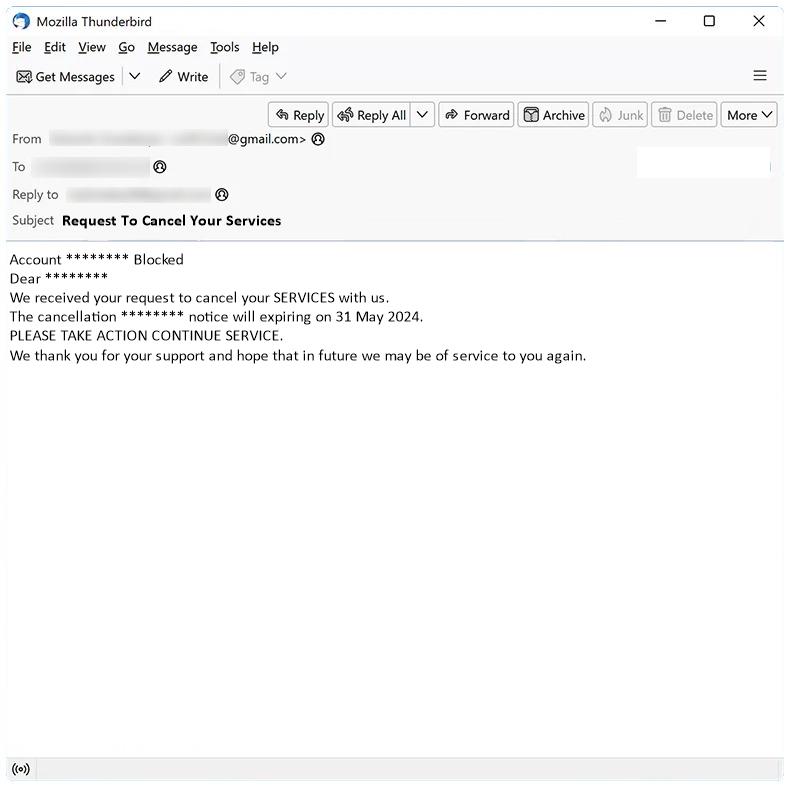What is “Request To Cancel Your Services” e-mail scam
Request To Cancel Your Services email spam is a type of phishing scam where cybercriminals send emails pretending to be from a legitimate company or service provider, requesting the recipient to cancel their services. The email typically contains a link or attachment that, when clicked or opened, can infect the recipient’s computer with malware or lead to a phishing website designed to steal personal information.
Interacting with Request To Cancel Your Services email scam can pose several risks, including:
1. Malware infection: Clicking on links or opening attachments in the email can lead to the installation of malware on your computer, which can steal sensitive information, disrupt your system, or give cybercriminals unauthorized access.
2. Phishing: Visiting a phishing website through the email can result in the theft of personal information, such as login credentials, credit card details, or other sensitive data.
3. Financial loss: Some Request To Cancel Your Services scams may trick recipients into providing payment information or making unauthorized transactions, leading to financial loss.
To protect yourself from Request To Cancel Your Services email spam, it is important to be cautious and follow these tips:
1. Do not click on links or open attachments in unsolicited emails, especially if they are requesting sensitive information or seem suspicious.
2. Verify the legitimacy of the email by contacting the supposed sender through their official website or customer service number.
3. Use up-to-date antivirus software and spam filters to help detect and block malicious emails.
4. Report any suspicious emails to your email provider or relevant authorities to help prevent others from falling victim to the scam.

Download Automated Solutions
Anti-spam solution
Mailwasher is a user-friendly anti-spam tool designed for both individuals and businesses. It stands out for its unique approach to spam management: it allows users to preview emails on the server before they are downloaded to their computer or mobile device. This feature enables users to effectively screen and delete unwanted messages, preventing spam from ever reaching their inbox.
Anti-malware solution
SpyHunter 5 is a powerful malware detection and removal tool developed by EnigmaSoft Limited. It’s designed to provide robust protection against a wide range of malware threats, including viruses, trojans, worms, rootkits, and ransomware. SpyHunter 5 is particularly known for its effectiveness in dealing with complex and evolving malware types that traditional antivirus programs may struggle to detect.
How to set up spam filters manually
1. What Are Spam Filters?
Spam filters are algorithms used by email services to identify and isolate spam emails. They analyze various elements such as the sender’s reputation, message content, and user behavior.
2. How They Work in Popular Services
– Gmail: Uses advanced machine learning algorithms to categorize emails.
– Outlook: Employs a combination of user settings and Microsoft’s smart algorithms.
– Apple Mail: Integrates with macOS and iOS to provide user-controlled filtering.
Enhancing built-in filters, to stop scam like “Request To Cancel Your Services”
2. Setting Up filters and rules
Thunderbird
- Go to Tools > Message Filters and choose the email account.
- Click New, name your filter, and specify conditions and actions.
- Set the criteria and choose actions for emails that meet these criteria.
- Click OK to save and activate the filter.
Outlook
- Go to File > Manage Rules & Alerts.
- Click New Rule and follow the prompts to define conditions, actions, and exceptions.
- Choose conditions, specify actions, and set any exceptions.
- Name your rule, click Finish, and Apply.
Gmail
- Click the gear icon and go to See all settings.
- Go to Filters and Blocked Addresses tab and click Create a new filter.
- Create Filter Criteria: Enter criteria and click Create filter.
- Select actions and click Create filter.
Yahoo Mail
- Click the gear icon and go to More Settings.
- Filters: Select Filters and click Add new filters.
- Define Filter: Name your filter, set rules, and choose a folder for the messages.
- Save: Click Save to activate the filter.
Apple Mail
- Go to Mail > Preferences.
- Click the Rules tab and then Add Rule.
- Name your rule, set conditions and actions.
- Click OK to save and activate the rule.
User practices to reduce spam, like “Request To Cancel Your Services”
1. Marking Emails as Spam
Consistently marking unwanted emails as spam trains the filter, improving its accuracy over time.
2. Email Address Discretion
Avoid publicly displaying your email address. Consider using disposable email addresses for non-critical sign-ups.
3. Unsubscribe from Newsletters
Regularly unsubscribe from unwanted newsletters and marketing emails.
4. Be Wary of Phishing Attempts
Spam can be a gateway to phishing. Never click on suspicious links or download attachments from unknown sources.
5. Regularly Update Your Email Client
Keeping your email client updated ensures you benefit from the latest spam-fighting features.
Conclusion
Combating spam requires a multifaceted approach that includes the effective use of built-in spam filters, third-party tools, and vigilant personal practices. By regularly fine-tuning your email settings, staying educated on the latest spam trends, and employing smart email management practices, you can significantly reduce the impact of spam on your digital life. Remember, a clutter-free inbox not only enhances productivity but also contributes to a safer online environment.
